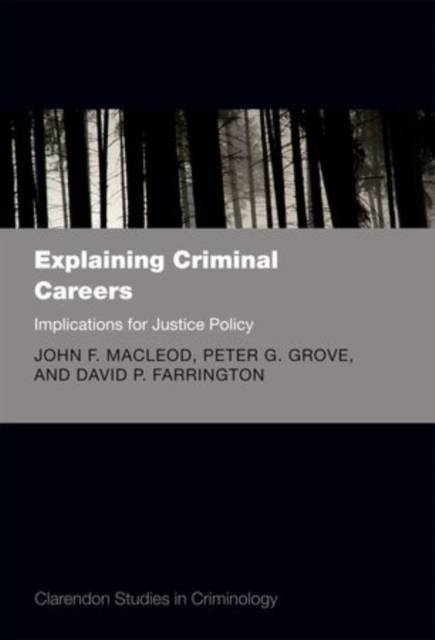
- Retrait gratuit dans votre magasin Club
- 7.000.000 titres dans notre catalogue
- Payer en toute sécurité
- Toujours un magasin près de chez vous
- Retrait gratuit dans votre magasin Club
- 7.000.000 titres dans notre catalogue
- Payer en toute sécurité
- Toujours un magasin près de chez vous
Explaining Criminal Careers
Implications for Justice Policy
John F MacLeod, Peter G Grove, David P Farrington
123,95 €
+ 247 points
Description
This is an open access title available under the terms of a CC BY-NC-ND 3.0 International licence. It is free to read at Oxford Scholarship Online and offered as a free PDF download from OUP and selected open access locations. Explaining Criminal Careers presents a simple but influential theory of crime, conviction and reconviction. The assumptions of the theory are derived directly from a detailed analysis of cohort samples extracted from the Home Office Offenders Index - a unique database which contains records of all criminal (standard list) convictions in England and Wales since 1963. In particular, the theory explains the well-known Age/Crime curve. Based on the idea that there are only three types of offenders, who commit crimes at either high or low (constant) rates and have either a high or low (constant) risk of reoffending, this simple theory makes exact quantitative predictions about criminal careers and age-crime curves. Purely from the birth-rate over the second part of the 20th century, the theory accurately predicts (to within 2%) the prison population contingent on a given sentencing policy. The theory also suggests that increasing the probability of conviction after each offence is the most effective way of reducing crime, although there is a role for treatment programmes for some offenders. The authors indicate that crime is influenced by the operation of the Criminal Justice System and that offenders do not 'grow out' of crime as commonly supposed; they are persuaded to stop or decide to stop after (repeated) convictions, with a certain fraction of offenders desisting after each conviction. Simply imprisoning
offenders will not reduce crime either by individual deterrence or by incapacitation. With comprehensive explanations of the formulae used and complete mathematical appendices allowing for individual interpretations and further development of the theory, Explaining Criminal Careers represents an innovative and meticulous investigation into criminal activity and the influences behind it. With clear policy implications and a wealth of original and significant discussions, this book marks a ground-breaking chapter in the criminological debate surrounding criminal careers.
offenders will not reduce crime either by individual deterrence or by incapacitation. With comprehensive explanations of the formulae used and complete mathematical appendices allowing for individual interpretations and further development of the theory, Explaining Criminal Careers represents an innovative and meticulous investigation into criminal activity and the influences behind it. With clear policy implications and a wealth of original and significant discussions, this book marks a ground-breaking chapter in the criminological debate surrounding criminal careers.
Spécifications
Parties prenantes
- Auteur(s) :
- Editeur:
Contenu
- Nombre de pages :
- 272
- Langue:
- Anglais
- Collection :
Caractéristiques
- EAN:
- 9780199697243
- Date de parution :
- 25-10-12
- Format:
- Livre relié
- Format numérique:
- Genaaid
- Dimensions :
- 223 mm x 146 mm
- Poids :
- 459 g







